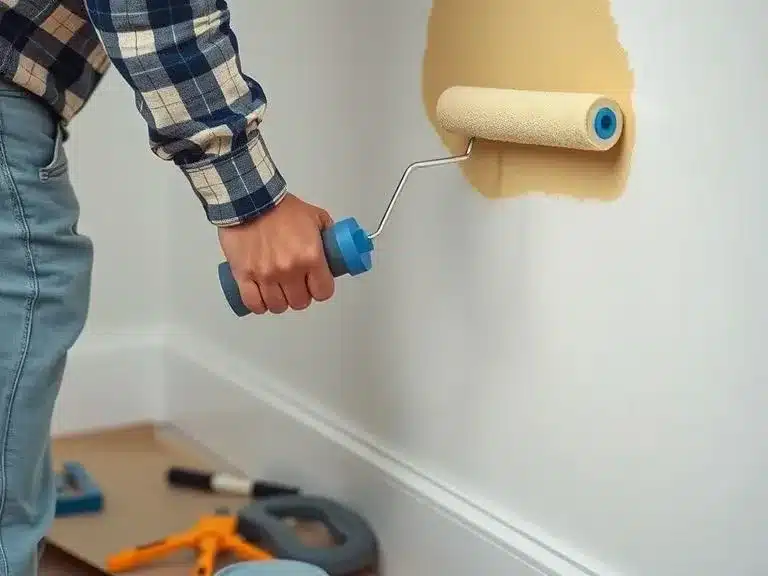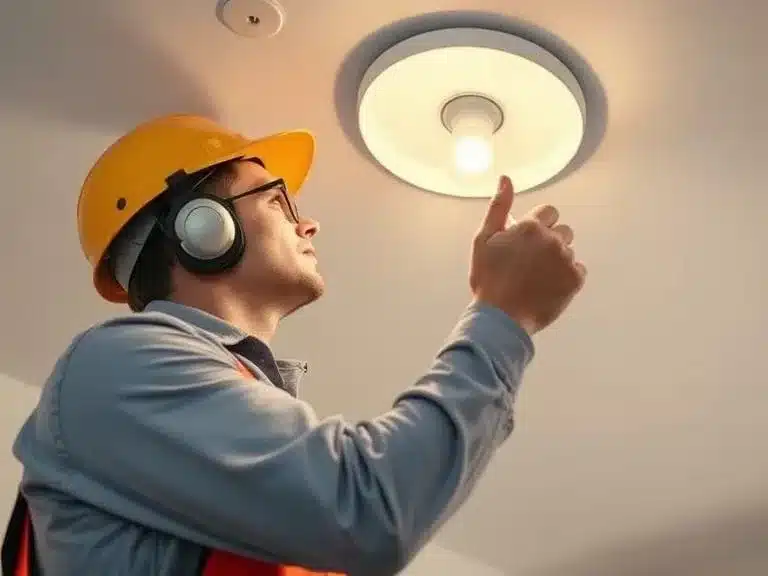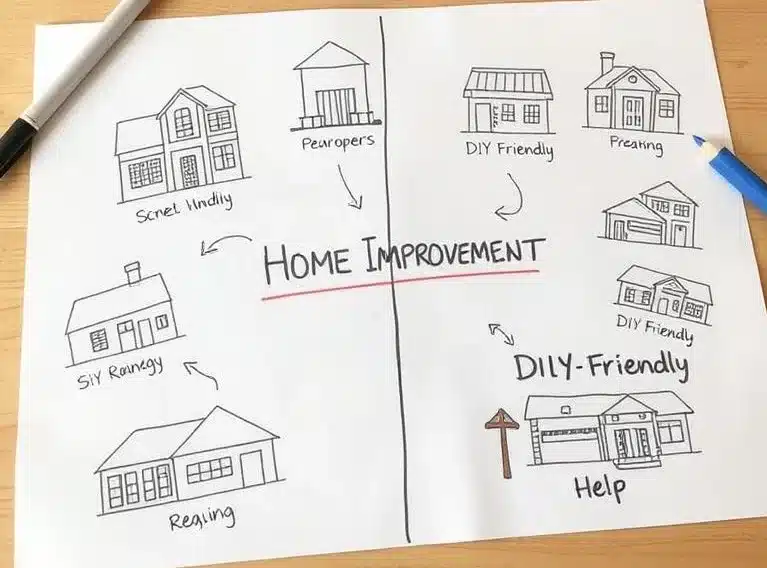Home renovations can be exciting but also overwhelming. When planning a project, one big question comes up: Should you do it yourself or hire a professional?
DIY renovations can save money and give you full control over the project. But they also take time, effort, and the right skills. On the other hand, hiring pros ensures quality work, but it comes at a higher cost.
Both options have their pros and cons. The right choice depends on your budget, experience, and the type of work needed. In this guide, we’ll break down the benefits and drawbacks of both approaches. This will help you decide which one is best for your home project.
Let’s get started!
Understanding DIY Renovations

What Is DIY Renovation?
DIY (Do-It-Yourself) renovation means handling home improvement projects on your own. Instead of hiring a professional, you take full control of the work.
Many homeowners choose DIY for small and medium projects. Common DIY tasks include painting walls, installing light fixtures, tiling, and even simple plumbing fixes. With the right tools and tutorials, many home upgrades are possible without professional help.
But is DIY always the best option? Let’s look at the pros and cons.
Pros of DIY Renovations
1. Cost Savings
One of the biggest reasons people choose DIY is to save money. Labor costs can make up a large part of renovation expenses. By doing the work yourself, you only pay for materials and tools.
👉 Recommended: Affordable DIY toolkits, paint rollers, and lighting fixtures to cut costs.
2. Creative Control & Personal Satisfaction
DIY lets you make all the decisions. You can pick the materials, design, and finishing touches without relying on anyone else. Plus, completing a project with your own hands brings a sense of accomplishment.
👉 Recommended: Customizable lighting options, pendant lights, and smart home décor to personalize your space.
3. Flexibility in Timeline
When you do it yourself, you can work at your own pace. No need to wait for contractor availability. This is great for small projects that can be done in stages.
4. Learning New Skills
Each DIY project teaches you something new. Over time, you gain valuable home improvement skills that can save you money in the long run.
Cons of DIY Renovations
1. Time-Consuming
DIY takes longer than hiring a professional. If you have a busy schedule, completing a project may take weeks or even months.
2. Risk of Mistakes
Without experience, mistakes can happen. A poorly done job may need expensive repairs later.
👉 Recommended: DIY-friendly tools and easy-to-install home improvement kits to reduce errors.
3. Lack of Professional Finish
Some tasks require expert craftsmanship. Tiling, woodworking, or drywall finishing can be tricky to get right. The final result might not look as polished as professional work.
4. Safety Risks
Handling electrical work, plumbing, or heavy tools can be dangerous. A simple mistake could lead to injuries or major home damage.
👉 Recommended: Safety gloves, protective glasses, and beginner-friendly power tools to stay safe.
DIY renovations can be a great way to save money and personalize your home. But they also come with challenges. Up next, we’ll look at what happens when you hire professionals instead.
Hiring Professionals for Home Renovation

What Does It Mean to Hire Professionals?
Hiring professionals means paying experts to handle your renovation projects. These can be contractors, electricians, plumbers, or interior designers. They have the skills, experience, and tools to complete the job efficiently.
For small projects, DIY may be enough. But for larger tasks—like rewiring a house, installing a new roof, or remodeling a kitchen—hiring a pro is often the safer and smarter choice.
Now, let’s go over the pros and cons of hiring professionals.
Pros of Hiring Professionals
1. Expertise & High-Quality Work
Professionals are trained to do the job correctly. They follow building codes and ensure a high-quality finish. This is especially important for electrical work, plumbing, or structural change projects.
👉 Recommended: Luxury chandeliers, high-end kitchen lighting, and professional-grade materials for a polished finish.
2. Saves Time
A professional team can complete a renovation much faster than a DIY project. They know what they’re doing and have the right tools to do the job efficiently.
3. Access to Better Materials & Resources
Contractors often have access to high-quality materials at wholesale prices. They also have the right equipment to handle complex tasks.
👉 Recommended: Contractor-grade paints, smart home systems, and premium flooring materials for professional results.
4. Warranties & Insurance Coverage
Most professionals offer warranties on their work. If something goes wrong, they will fix it. Many contractors also have insurance, protecting you from liability in case of accidents.
Cons of Hiring Professionals
1. High Costs
Labor costs can be expensive, sometimes making up more than half of a renovation budget. If you’re on a tight budget, this can be a major downside.
2. Less Personal Control
When you hire a contractor, you need to trust their process. While you can provide input, the final execution may not be exactly as you imagined.
3. Scheduling & Delays
Professionals work on multiple projects, so you may have to wait for them to start or finish your renovation. Delays can happen due to scheduling conflicts, permits, or unexpected issues.
4. Risk of Hiring the Wrong Contractor
Not all contractors are reliable. Some may overcharge, do poor-quality work, or take longer than promised. Proper research is essential before hiring.
Hiring professionals ensures quality work, but it comes with a higher price tag. So, how do you decide which approach is best? In the next section, we’ll compare DIY vs. hiring pros side by side.
Which Approach Works Best for Different Projects?

Not all home renovations are equal. Some projects are perfect for DIY, while others require professional expertise. Here’s a breakdown of which method works best for different types of renovations.
Best Projects for DIY
✅ Painting Walls & Cabinets is one of the easiest DIY tasks. With the right tools and techniques, you can get a smooth, professional-looking finish.
👉 Recommended: Paint rollers, painter’s tape, and DIY-friendly wall paint
✅ Installing Light Fixtures – Swapping out old lighting for new chandeliers, pendant lights, or LED strips is simple if you follow safety precautions.
👉 Recommended: Easy-to-install smart lighting, ceiling fans with lights, and pendant lights
✅ Laying Vinyl or Laminate Flooring – Peel-and-stick or click-together flooring makes this a beginner-friendly DIY project.
👉 Recommended: underlayment pads
✅ Backsplash Installation – Peel-and-stick backsplash tiles are budget-friendly and easy to install.
👉 Recommended: Self-adhesive backsplash tiles for kitchens and bathrooms
✅ Furniture Assembly & Small Woodworking Projects – Building shelves, assembling cabinets, or making a custom headboard can be fun and rewarding.
👉 Recommended: Power drills, toolkits, and floating shelf sets
Projects That Require a Professional
❌ Electrical Work – Wiring mistakes can lead to fire hazards or serious injuries. It’s always safer to hire a licensed electrician.
❌ Plumbing & Pipework – Fixing leaks is manageable, but major plumbing work (like installing a new sink or water heater) should be left to the pros.
❌ Structural Changes – Removing walls, adding extensions, or modifying load-bearing structures requires engineering knowledge.
❌ Roofing & Major Exterior Work – Roofing mistakes can lead to leaks, mold, or costly repairs. Professionals ensure proper installation.
❌ HVAC Installation & Repairs – Heating, ventilation, and air conditioning systems require specialized knowledge for safety and efficiency.
Hybrid Approach: Mixing DIY & Professional Help
For some projects, a mix of DIY and professional work is the best approach.
🔹 Kitchen Renovations – DIY tasks like painting cabinets and installing a backsplash, but hire pros for plumbing and electrical work.
🔹 Bathroom Upgrades – DIY wall décor and lighting, but leave sink or shower installations to professionals.
🔹 Landscaping – DIY for planting and garden décor, but hire pros for irrigation systems or large tree removals.
Choosing the right approach depends on your skills, budget, and project complexity. In the next section, we’ll share tips to help you make the best decision for your renovation.
Conclusion
Both DIY renovations and hiring professionals have their pros and cons. DIY can save money and give you creative control, but it requires time, effort, and skill. Hiring professionals ensures quality work and saves time but comes at a higher cost.
The best approach depends on the project. Simple tasks like painting and lighting upgrades are great for DIY, while complex jobs like electrical work and plumbing should be left to professionals. A mix of both can often be the best solution.
Whichever path you choose, plan carefully, use the right tools, and prioritize safety.
Thanks for reading! Happy renovating! 😊
FAQs
Is DIY renovation cheaper than hiring professionals?
Yes, DIY renovations are usually cheaper because you only pay for materials and tools, not labor. However, mistakes can lead to extra costs, so it’s important to have the right skills before starting a project.
What are the biggest risks of DIY home renovations?
The main risks include safety hazards (electrical work, heavy tools), violating building codes, and making costly mistakes that require professional fixes. It’s best to research thoroughly and start with smaller projects.
When should I hire a professional instead of doing it myself?
You should hire a pro for complex tasks like electrical work, plumbing, HVAC installation, roofing, or any project involving structural changes. These require specialized skills and must follow safety regulations.
Can I mix DIY and professional help in a single renovation project?
Absolutely! Many homeowners choose a hybrid approach—doing simple tasks like painting or installing light fixtures themselves while hiring professionals for technical jobs like wiring and plumbing. This saves money while ensuring quality work where needed.
Recent Posts
- 10 Best Nesting Tables for Small Spaces and Apartments
- 10 Best Ladder Bookshelves for Stylish Home Organization
- 9 Best Storage Trunks for Home Organization and Style
- 10 Best Room Dividers for Privacy and Stylish Spaces
- 11 Best Bar Carts for Entertaining Guests in Style
- 10 Best Decorative Accent Cabinets for Stylish Home Storage
- 9 Best Convertible Futons and Sofa Beds for Small Apartments
- 10 Best Modular Furniture Sets for Flexible and Functional Living
- 10 Best Cube Storage Units for Organized and Stylish Homes
- 9 Best Closet Organizer Systems for Maximizing Your Space
- 10 Best Murphy Beds and Wall Beds for Small Guest Rooms
- 15 Best Folding Furniture Pieces for Small Apartments and Studios
- 12 Best Storage Ottomans for Small Spaces and Apartment Living
- 9 Best Activity Tables for Kids for Fun and Learning
- 9 Best Kids’ Dressers for Organized Bedrooms
















